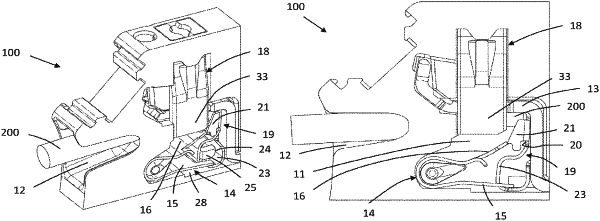| CPC H01R 4/48365 (2023.08) | 12 Claims |

|
1. A connecting terminal for connecting an electrical conductor, the connecting terminal comprising:
a housing within which a conductor connection chamber is formed;
a conductor insertion opening formed in the housing, via which the electrical conductor to be connected is insertable into the conductor connection chamber along an insertion direction;
a current bar arranged in the conductor connection space of the housing;
a clamping spring arranged in the conductor connection chamber and having a retaining leg and a clamping leg, wherein the clamping leg is transferrable into a clamping position and into an open position; and
an actuating element, which is arranged displaceably in the housing along an actuating direction,
wherein the clamping leg of the clamping spring is actuatable by the actuating element in order to transition from the clamping position into the open position,
wherein the actuating direction of the actuating element is formed transversely to the insertion direction of the conductor into the conductor connection chamber, and a retaining element is arranged in the conductor connection chamber of the housing, on which retaining element the clamping leg is held in the open position and from which the clamping leg is released in the clamping position,
wherein the retaining element has a pressure surface which is arranged transversely to the insertion direction of the conductor and which is actuatable by means of the conductor to be connected in order to release the clamping leg from the retaining element for transfer from the open position into the clamping position, and
wherein the retaining element is fastened to the clamping spring or to the current bar.
|